Military robots and their developers. Part 3 - Final
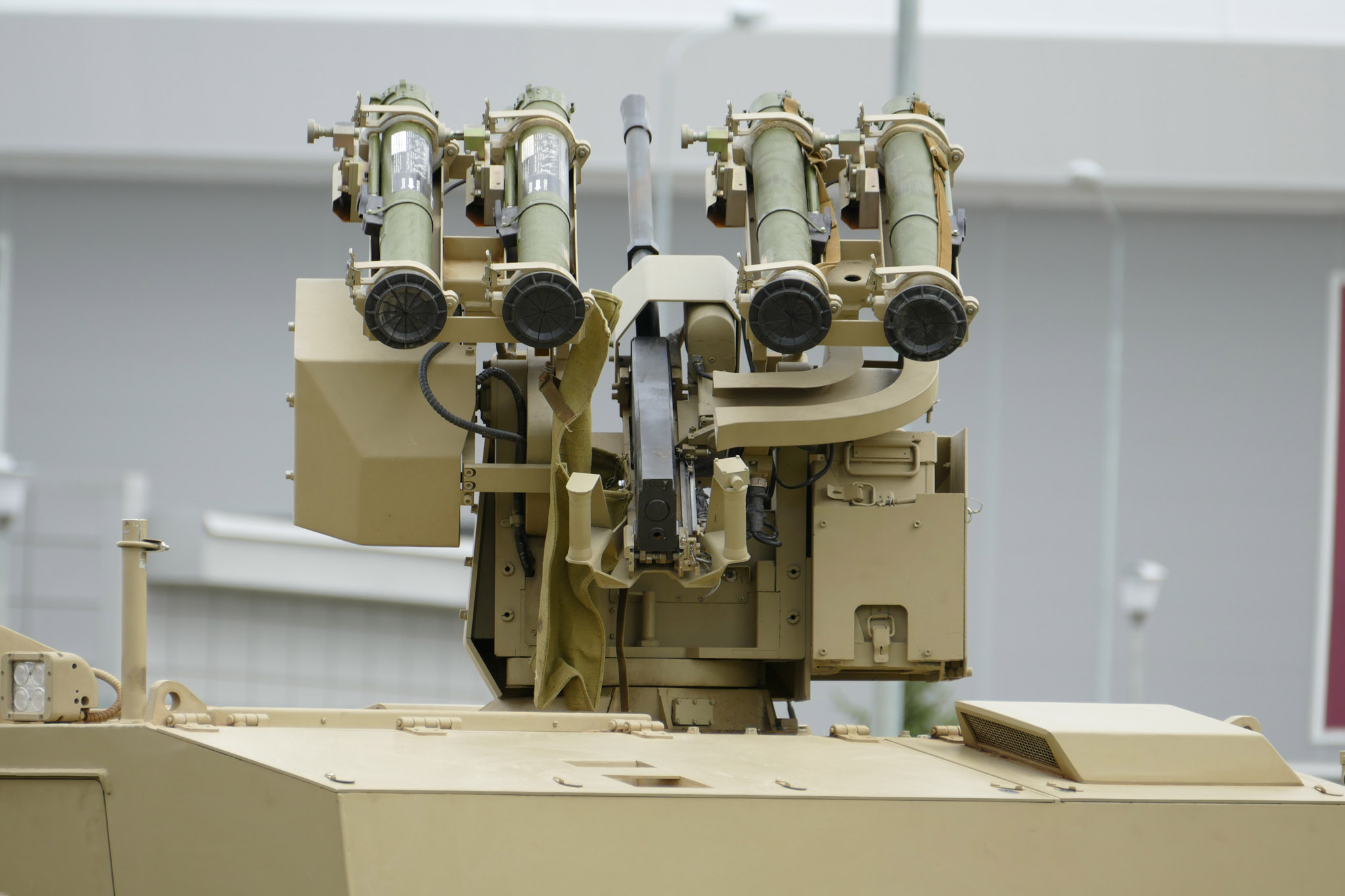
The last part of a large review of military robots. In the first and second post, the developments of China and India were not considered, but now we will fix this. Although the emphasis is still on Russian robots.
Kalashnikov Concern, Russia
This name has become the most popular arms manufacturer in Russia since 2013. Prior to that, he was OAO NPO IZHMASH. And before that (until 1975) he bore the name of Izhevsk Machine-Building Plant, which had previously been Izhevsk Arms Plant, originating in 1807. From the day of its foundation until 1866, the plant manufactured one third of all small arms in Russia — about a million guns. At that time, cold arms — sabers, halberds, pikes, broadswords — were forged at the factory. By the centenary (1907), the plant had produced more than 4 million weapons. During the Great Patriotic War, the plant produced about 12,000 Mosin rifles per day and began to master the production of air cannons. In the post-war years, he made, among other things, motorcycles and automobiles, nicknamed "Izhami" by the people. Today, the concern produces combat, hunting, civilian and sporting weapons, UAVs, guided combat modules and multifunctional boats.

The BAS-01G BM "Companion" is a combat automated system that is designed for mine clearance and fencing off, patrolling and guarding facilities , fire support and reconnaissance. Machine guns of a caliber of 12.7 mm and 7.62 mm, grenade launchers of the AG-17A type with a caliber of 30 mm, automatic grenade launchers with a caliber of 40 mm and up to 8 Kornet-EM rocket launchers can be placed on the combat module. With a mass of 7 tons, its power reserve is 400 km. Maximum speed of 40 km / h. Works in passive mode up to 10 days. It detects targets at a distance of up to 2500 m. It is controlled remotely at a distance of up to 10 km from the operator. For technical vision are the cameras equipped with thermal imagers.
Central Research Institute of Robotics and Technical Cybernetics (RTK), Russia
Founded January 29, 1968 on the basis of the Leningrad Polytechnic Institute. At that time, it was called the “Special Design Bureau of Technical Cybernetics” (OKB TC), after which in June 1981 it was transformed into the Central Research Institute of Radio Engineering. During the existence of the USSR, OKB TK developed systems for controlling the soft landing of the Soyuz spacecraft and the AMS Luna. Already with the rank of TsNII RTK, he developed mobile robots to eliminate the consequences of the accident at the Chernobyl nuclear power plant in 1986-1987. Now the institute is working on the creation of robotic multifunctional complexes, radiation monitoring systems, spacecraft life support systems, vision systems, network processors.

“Platform-Argo” is a combat robotic complex on a wheel course designed primarily for fire support and reconnaissance. Able to move through rugged mountainous and wooded areas. If necessary, the complex can be put on the tracks. The bottom is protected and has an extremely low center of gravity. In the standard version, it is equipped with a Kalashnikov tank gun (7,62 mm caliber), three RPG-26 72.5 mm anti-tank grenade launchers and one 72.5 mm RSHG-2 assault grenade launcher. Able to reach speeds of up to 20 km / h on land and up to 2.5 knots in water, while it can operate continuously for 20 hours. With dimensions of 335x185x165 cm, its curb weight does not exceed 1020 kg. The robot participated in the hostilities in Syria: in Latakia, four Argo complexes attacked militant positions with the support of Syrian troops.
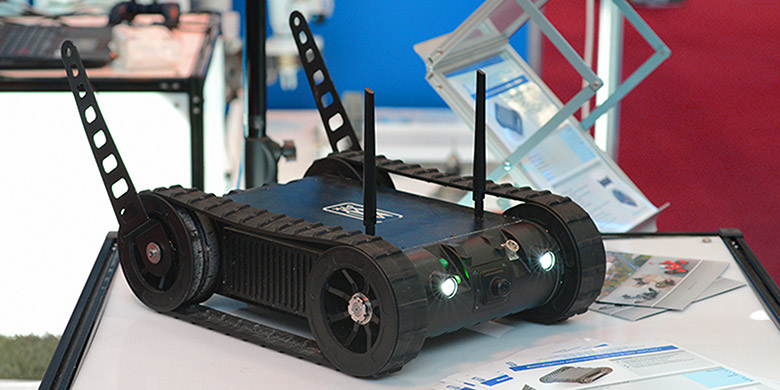
"Cadet" - small-sized robotic platform, which is designed for conducting reconnaissance and delivery of small loads. Equipped with two review video cameras with backlight and swivel flippers that can rotate the robot, if necessary. With a size of 45x35x15 cm and a mass of 15 kg, it is able to move at a speed of 1 m / s. It has a Pickattini bar, so that the robot can carry loads weighing up to 10 kg. It works autonomously for 2 hours and overcomes slopes up to 30 degrees. It is controlled remotely at a distance of 400 meters from the operator.

"RTK-05" - a robot capable of conducting radiation and chemical reconnaissance in remote areas, industrial and residential premises. Makes a dose cartogram, following the route of intelligence. Equipped with a manipulator for interacting with objects, video cameras, stereo pairs, laser and sound range finders. Robot dimensions: 148x65x80 cm. With a mass of 300 kg, it can move at a speed of 0.5 m / s and work autonomously for up to two hours. The manipulator lifts objects weighing up to 10 kg.
OJSC “Plant them. V.A. Degtyareva ", Russia
The construction of the plant began on August 27, 1916 in Kovrov (Vladimir region). Among the first, the plant received a license to manufacture the Madsen machine-gun. After the October Revolution, the Danish part of the administration tried to dismantle and remove the equipment, but the factory’s workers did not allow it. In 1918, the plant was temporarily closed due to lack of money. But in July 1919 he was nationalized, and by 1920 more than 1 thousand workers worked on it. He carried the name "Kovrov Machine-Tool Plant", "Tool Plant No. 2", "Tool Plant No. 2 named after K.O. Kirkizha ”, and in 1949 the enterprise was renamed into the plant named after V.A. Degtyarev. In 1940 he began to produce the legendary PPSH. And with the beginning of the Great Patriotic War, the plant switched to the round-the-clock mode. Now it produces weapons, motorcycles, industrial sewing machines, batteries and equipment for the food industry.
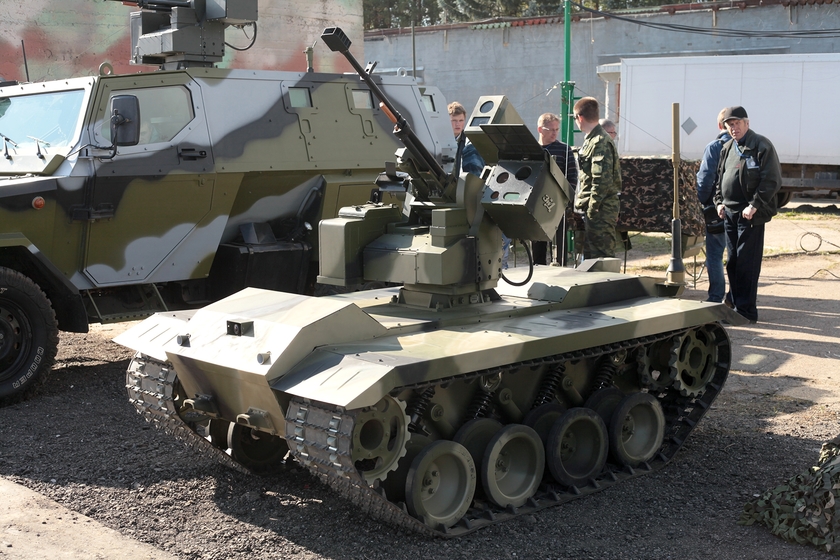
Nerekhta is a combat robotic complex developed on behalf of the Advanced Research Foundation (Russian equivalent of DARPA ). The platform of the robot is modular, so that it can be turned into a combat, reconnaissance or transport apparatus. The combat gear is equipped with a 12.7 mm heavy machine gun “Kord” or a 7.62 mm Kalashnikov tank machine gun (PKT), as well as an automatic AG-30M 30 mm caliber grenade launcher. It is possible to install and anti-tank missile system "Cornet". Equipped with laser video cameras, laser range finder, thermal imaging camera. The maximum target detection range with a combat module is 3000 m. With an artillery reconnaissance module, 5000 m. The effective target destruction range is 1000 m. It moves on a track with a speed of up to 32 km / h. Platform weight without modules - 1000 kg, load capacity - 500 kg. The armor of the robot can withstand the hit of a 7.62 mm caliber bullet fired from a sniper rifle or machine gun (protection class - 5). The variant with the transport module is equipped with a manipulator, a coupling device, a winch with a trawl and a shipping container.
Research Institute of Special Engineering Moscow State Technical University named after NE Baumana, Russia
NIISM originates in 1971 - then it was called the Scientific Research Institute of Mechanical Engineering Problems (NIIPM) and was the next structure of the university as a branch defense research institutes. Developed new types of ammunition and artillery systems. In 1988 he began to bear the name, which has survived to this day. In the 90s of the last century, the scientific research institute experienced serious difficulties due to cuts in public funding. Then it was decided to organize their own design bureaus in the divisions of NIISM. Thanks to this, the institute was able to accept civilian orders as well. Now NIISM is developing large-size structures for the space industry, launching missile systems, pulse systems, rocket and trunnion systems, location systems, automobiles and robotic devices.

Varan is a mobile robotic complex that is designed for searching and diagnosing explosive devices. The first prototype of the robot was published in 2003. Adopted by the Armed Forces of the Russian Federation. The mass of the robot is 185 kg. It can work autonomously for up to 4 hours, moving under an incline of up to 20 degrees. The manipulator extends 1 meter from the front edge of the case and is capable of lifting loads up to 30 kg in a fully extended condition, and up to 50 kg when folded up. The robot places dangerous devices in special evacuation containers. It can even work in the snow, but with a cover height of not more than 15 cm.

Tornado is an off-road robot used for remote reconnaissance and search for dangerous objects. The robot's chassis consists of two axles, each of which has six wheels (three on each side). Thanks to this, the robot is able not only to drive, but also to walk. Dimensions: 740x470x310 mm. At the same time, it can work in water and snow up to 30 cm deep. It overcomes longitudinal slopes up to 35 degrees. Able to work at temperatures from -40 ° C to + 40 ° C. On the wheel blocks you can install the tracks to improve cross-country ability. Construction weight - 45 kg.

"Vepr" - another robot designed to neutralize explosive objects. At the heart of its chassis is exactly the same scheme as the Tornado - four blocks of three wheels on each. Unlike "Varan", this robot-sapper can lift up to 100 kg when departing the manipulator from the axis to one meter. And in a fully extended state (2.8 m), it can manage loads up to 30 kg. Equipped with six color cameras and two cameras with zoom and day-night mode.

“Mongoose” is a small-sized reconnaissance robot whose main purpose is reconnaissance and search for dangerous objects. With dimensions of 34x42x15 cm, it weighs 6-10 kg and is equipped (depending on need) with one or four cameras, a microphone and an illuminator.

"All-terrain vehicle TM3" - a sapper robot, which is not only looking for, but also neutralizes explosive devices. For this purpose, it is equipped with a hydraulic destructor, which is held by a manipulator with four degrees of freedom. The mass of the device is 35 kg, the battery life is 75 minutes.
Northrop Grumman Corporation, USA
Northrop Grumman was formed in 1994, when the two major corporations Northrop Corporation and Grumman Corporation merged into one. This is one of the largest US companies operating in the US military-industrial complex and foreign customers. It develops and produces battleships, aircraft carriers, aircraft (attack aircraft, fighters, bombers), missile defense systems, navigation systems, and electronics for the space and medical industries. Northrop Grumman has a subsidiary, Remotec, which manufactures military robots.
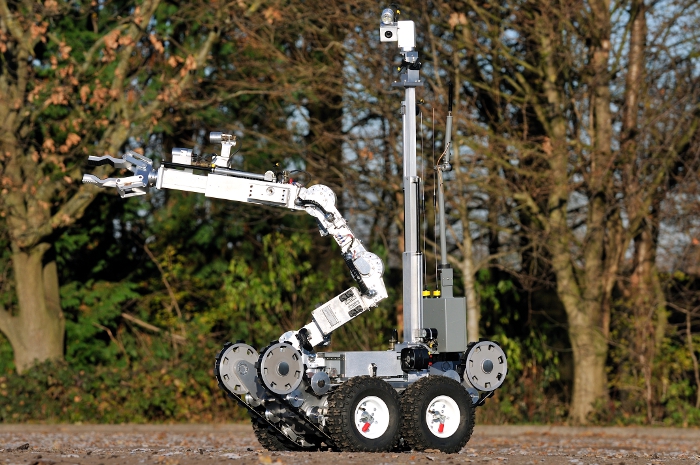
ANDROS is a whole series of robots whose main purpose is mine clearance of explosive devices and shells. The basic version of the F6-A weighs 220 kg and is equipped with four color cameras. And its predecessor, the F-5 robot, was used to kill a criminal who attacked police officers in Texas in July 2016. The MarkV-A1 has a similar design, but slightly larger than the F6-A - it weighs 358 kg; equipped with a water cannon and, if necessary, a shotgun. The largest ANDROS family is the Wolverine sapper, whose weight is 367.4 kg. And the smallest and newest in the ANDROS line is the HD-1 robot, which weighs only 90 kg; This robot sapper was successfully used by the engineering forces of Israel.

Wheelbarrow Mk.9 is another sapper robot, but different in chassis type from ANDROS robots. The Wheelbarrow Mk.9 has a modified and noticeably narrower tracked drive. Its dimensions are 135x63x124 cm. With a weight of 330-350 kg it can move at a speed of up to 5 km / h and work autonomously for up to three hours. The manipulator has seven degrees of freedom. In the fully extended state, it is able to move loads weighing up to 20 kg, in the assembled one - up to 150 kg. The robot is equipped with a set of cameras - up to 10 pieces, depending on the complexity of the task.
Lockheed Martin, United States
The company was formed in March 1995 as a result of the merger of two corporations - Lockheed Corporation and Martin Marietta Corporation. Now it is the world's largest supplier of military equipment in terms of the amount of contracts concluded (following the results of at least 2016, 2015 and 2014). It develops and manufactures products for the aerospace industry, aviation, fleet, security and technological areas. The company has been awarded the Collier Trophy six times for achievements in the field of aeronautics.

MULE is a three-axis robotic platform, on the basis of which transport, engineering, combat and reconnaissance robots are built. The transport variant with the designation XM1217 is equipped with a module that can hold up to 1090 kg of cargo. It is also intended to evacuate the wounded from the battlefield, to transport ammunition and transport personnel. If necessary, it can serve as a shelter - the robot significantly reduces ground clearance and protects from shelling. The XM1218 version of the robot is designed to detect and neutralize mines, as well as to conduct reconnaissance. The combat version of the ARV-A is essentially a light tank with additional armor shielding of the upper part of the chassis. It weighs 9.3 tons and is equipped with a 30-mm Mk 44 caliber cannon, as well as a 7.62 mm M240 machine gun. Additionally, you can install an automatic XM307 ACSW grenade launcher for 25x59 mm grenades, as well as an anti-tank missile system. The ARVA-L modification is additionally equipped with a retractable periscopic viewing tube, equipment for radiochemical and bacteriological reconnaissance, directors of smoke interferences and a set of mine barriers.
Endeavor Robotics, USA
A team of engineers and developers who previously worked for iRobot (it was mentioned in the second part of the review of military robots). Still produces such devices as Firstlook and Packbot, but there is also a separate development of its own - Kobra.

Kobra is a sapper robot. With its own weight of 226.7 kg, the robot is able to lift objects weighing 150 kg in folded form and 35 kg in fully stretched ones. The reach of the manipulator is 190.5 cm. The robot is equipped with four cameras and can reach speeds of up to 12.9 km / h. However, it can move on surfaces under an impressively large gradient of 55 degrees. It can work autonomously for up to 10 hours.
Defense Research and Development Organization (DRDO), India
An organization that not only finances military developments following the example of DARPA, but also itself deals with these developments. DRDO owns a network of 52 laboratories that create solutions in the field of aeronautics, weapons, electronics, ground combat equipment, natural sciences, materials, rockets and navigation. DRDO is the largest and most diverse research organization in India. As of May 2017, the organization employed five thousand scientists and 25 thousand people of scientific, technical and support staff. The DRDO robots are handled by the Center for Artificial Intelligence and Robotics (CAIR) laboratory.
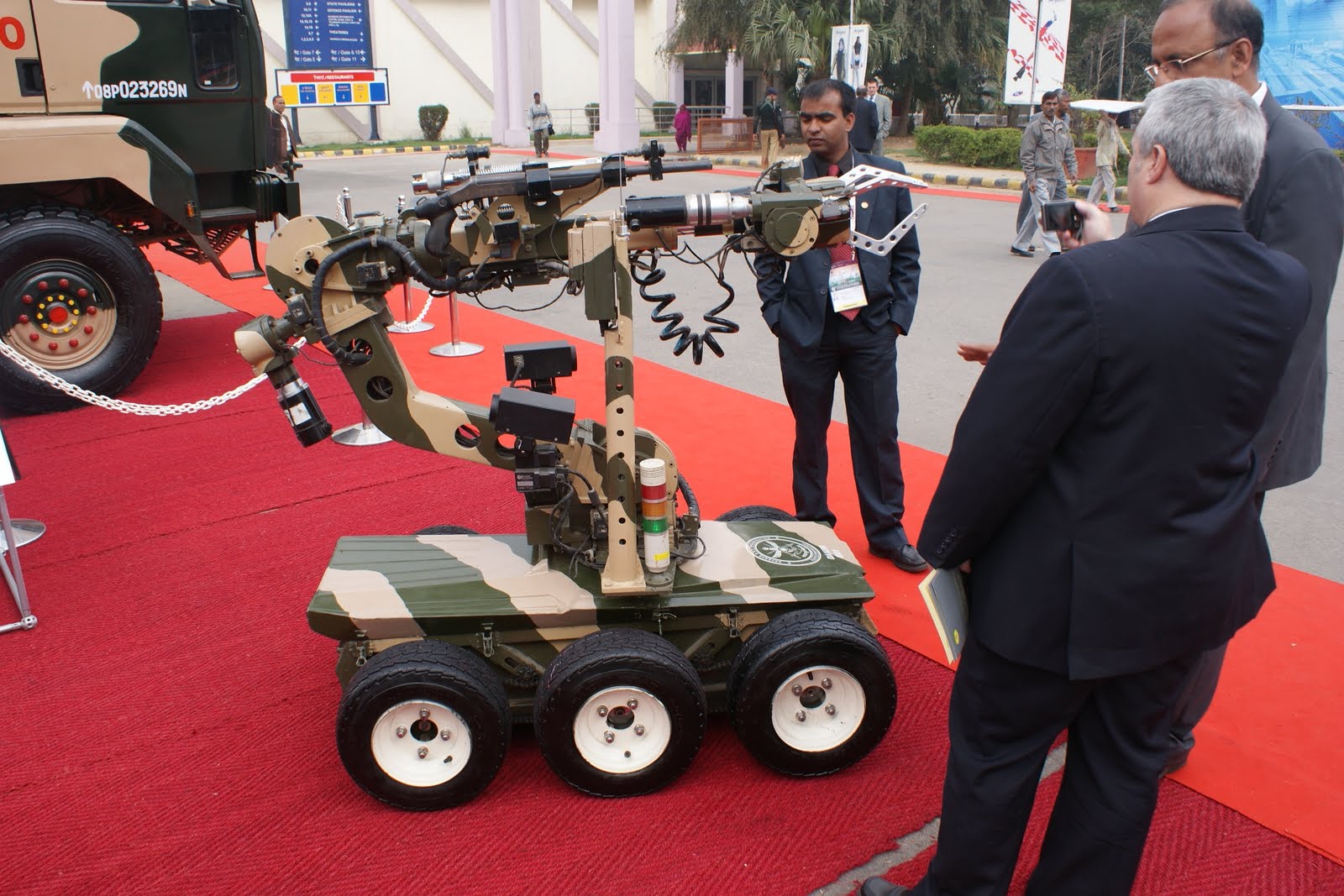
Daksh - a robot designed to interact with explosive devices. To determine the degree of danger of such a device, a robot can use a portable x-ray device, “shining through” the object. To neutralize dangerous objects, he can use a water cannon or a shotgun mounted on the platform. Also equipped with a radio frequency suppressor to block the signal to the explosion. For the review of the day and night vision cameras. The robot is controlled remotely at a distance of up to 500 m from the operator. Modification Daksh Warrior equipped with a machine gun MG3 7.62 mm and, if necessary, a grenade launcher.
Norinco, China
The name of the corporation comes from the English China North Industries Corporation. Founded in 1980 and controlled by the Committee on Science, Technology and Industry at the Ministry of Defense of the PRC. The military industry is only part of the corporation’s activities. It also engages in civil engineering, the production of chemical and light industrial goods, and it creates optical electronics, geological survey equipment, automobiles, and even motorcycles. Included in the list of 500 largest companies in China in terms of assets and income.

The Sharp Claw 1 is a robotic complex consisting of a transport module that carries a compact quadcopter on board a tracked robot. This module is equipped with cameras and acts as a repeater signal. Tracked robot, in turn, is designed for fire support and reconnaissance. A light machine gun of 7.62 mm caliber and a set of cameras are installed on it. Its length is 70 cm, and height - 60 cm.
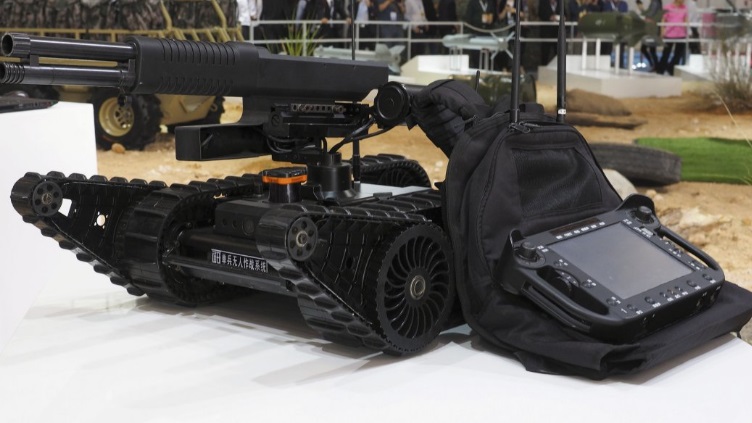
Battle Robot - as is evident from the name, this robot performs the tasks of fire support units in battle. Exact dimensions are unknown, but in comparison with other combat robots it can be called small. Equipped with tracked chassis with tracked flippers for better maneuverability. As the main armament manufacturer puts on the robot self-loading shotgun QBS 09 of the twelfth caliber. But it is argued that an automaton can be installed instead.

Da Gou is the Chinese version of the Big Dog American transport robot from Boston Dynamics . Translated from the Chinese, Da Gou means “Big Dog” (big dog). The essence is the same - to transfer the payloads of the unit. But the maximum weight that Da Gou can take on is limited to 50 kilograms. And his speed of movement can not be higher than 6 km / h. According to the manufacturer, he can overcome the slopes of steepness up to 30 degrees. The first versions of Da Gou were equipped with a special frame that prevented the robot from turning over.
To the beginning of the review
All Articles